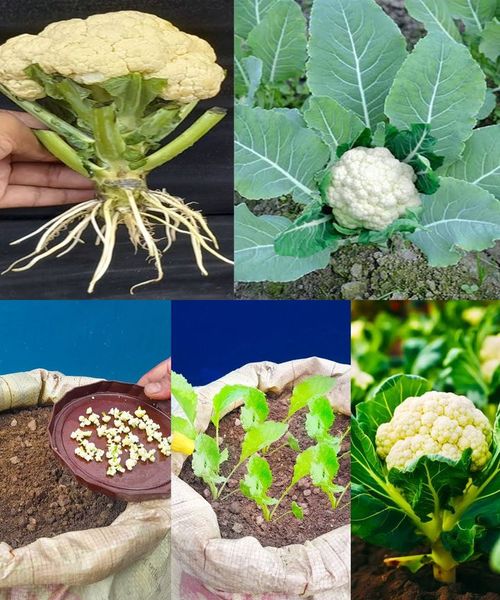Regrowing cauliflower from an existing plant base is a fun and sustainable gardening project, though it’s important to note that cauliflower won’t grow into a tree, but new heads can develop from the base. Here’s a detailed guide to regrowing cauliflower at home:
Materials Needed
- Fresh cauliflower with leaves and intact base
- Sharp knife
- Water
- Shallow container or dish
- Pot with well-draining soil
- Fertilizer (vegetable fertilizer is ideal)
Step-by-Step Instructions
- Select a Fresh Cauliflower:
- Choose a healthy cauliflower from the store or garden. Ensure the base has leaves and looks fresh and green.
- Prepare the Cauliflower Base:
- Use a sharp knife to cut off the cauliflower head, leaving 2-3 inches of the stem and base.
- Remove excess leaves, leaving only a few small leaves near the base to encourage root growth.
- Water the Base:
- Place the cauliflower base into a shallow dish with about an inch of water. Make sure that the bottom of the base is submerged, but not fully underwater.
- Place the dish in a spot with bright, indirect sunlight.
- Change the Water Regularly:
- Replace the water every 2-3 days to keep it fresh and prevent bacterial growth.
- Wait for Roots to Develop:
- In 1-2 weeks, roots should start forming from the bottom of the base. You may also see tiny leaves emerging from the center.
- Transplant into Soil:
- Once roots are about an inch long, the base is ready to be transplanted.
- Fill a pot with well-draining soil and make a hole in the center.
- Place the base into the soil, covering the roots but leaving the new growth above the soil line.
- Water thoroughly after transplanting.
- Care for the Cauliflower Plant:
- Position the pot in a sunny spot, ensuring it receives at least 6 hours of sunlight daily.
- Keep the soil consistently moist but avoid waterlogging.
- Fertilize every few weeks with a balanced vegetable fertilizer.
- Encouraging Growth:
- As the plant grows, remove any yellowing or damaged leaves to promote healthy growth.
- Once small cauliflower heads form, they can be harvested when they reach your preferred size.
- Optional: Transplant Outdoors:
- If you want to transplant the cauliflower into your garden, wait until the plant has strong roots and new growth.
- Prepare a sunny, well-drained spot in your garden by enriching the soil with compost.
- Space the plants adequately to allow for growth and ensure good air circulation.
Tips for Successful Regrowth
- Sanitize Tools: Always use clean, sharp knives or scissors to prevent the introduction of diseases.
- Consistent Watering: Maintain consistent moisture levels, but avoid waterlogging, which can cause root rot.
- Pest Management: Keep an eye on pests such as aphids, caterpillars, or slugs. Use organic pest control methods like neem oil or insecticidal soap if necessary.

